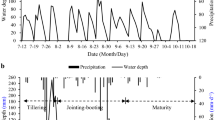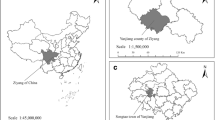Abstract
The present study was carried out during a period of one year (from May 1, 1997 to April 30, 1998) to quantify seasonal runoff of N and P in a rice field with an area of 5,000 m2. The total amount of runoff water was 1,043 mm during the cropping season and 281 mm during the non-cropping season. Nutrient concentrations in runoff water increased significantly during the period of fertilizer application and then decreased. During the non-irrigation period after harvest, however, the concentrations of tota -N were 3 to 4 mg l−1. The annual runoff loading of total-N and total-P was 157.9 and 4.5 kg ha yr−1. The runoff loading was 109.9 kg ha−1 for total-N and 3.5 kg ha−1 for total-P during the fertilizer application period (from May 13 to August 3, 1997). During the rainy season (from June 20 to July 20, 1997), the runoff loading was 66.1 kg ha−1 for total-N and 1.9 kg ha−1 for total-P. The runoff loading was 5.6 kg ha−1 for total-N and 0.2 kg ha−1 for total-P during the fallow stage (from October 1, 1997 to March 20, 1998) while it was 6.7 kg ha−1and 0.4 kg ha−1 for each nutrient during the plowing stage (March 20 to May 10, 1998). The loss of total-N and total-P was 68.2% and 63.9% of annual runoff loading during the fertilizer application stage, respectively. During the non-cropping season after harvest, however, the loss was 30.4% of total-N and 22.3% of total P. In summary, intensive long-term studies on various sites of nutrient management planning during the fertilizer application and rainy seasons are needed.
Similar content being viewed by others
References
Chescheir G.M., Gilliam J.M., Skags R.W and Broadhead R.G. 1991. Nutrient and sediment removal in forested wetlands receiving pumped agricultural drainage water. Wetlands 11: 87–103.
Chung J.B., Kim M.K., Kim B.J. and Park W.C. 1999. Nitrogen, phosphorus and organic carbon load in the Imgo small agricultural watershed catchments. Korean Soc. Environ. Agri. 18: 70-76.
Coale F.J., Porter P.S. and Davis W. 1994. Soil amendments for reducing phosphorus concentration of drainage water from Histosols. Soil. Sci. Soc. Am. J. 58: 1470-1475.
Jung Y.S., Yang J.E., Park C.S., Kwon Y.G. and Joo Y.K. 1998. Changes of stream water quality and loads of N and P from the agricultural watershed of the Yulmunchon tributary of the BukHan river basin. J. Korean Soc. Soil. Sci. Fert. 31: 170-176.
Kim B.Y. and Cho J.K. 1995. Nutrient effluence by the outflowing water from the paddy field during rice growing season. Korean Comm. Irrig. Drain. 2: 150-156.
Kunimatsu T., Rong L., Sudo M. and Takeda I. 1994. Runoff loadings of materials causing water pollution from a paddy field during a non-planting period. Jpn. Soc. Irrig. Drain. Reclam. Eng. 170: 45-54.
Lee C.K., Lee K.C., Lee H.J., Rhu H.I., Lee M.H., Jun S.H. et al. 1990. Studies on good agricultural practice in the use of fertilizer and agrochemical Rep. Korean Environ. Res. 12: 293-310.
Ministry of Agriculture and Forestry 1998. Statistical Yearbook of Agriculture & Forestry. Seoul, Korea.
Murphy J. and Riley J.P. 1962. A modified single solution method for the determination of phosphate in natural waters. Anal. Chim. Acta 27: 31-36.
O'Connor P.W. and Syers J.K. 1975. Comparison of methods for the determination of total phosphorus in waters containing particulate material. J. Environ. Qual. 4: 347-350.
OECD 1996.Water pollution by fertilizers and pesticides. OECD, Paris.
Park S.W., Yoo S.H. and Kang M.S. 1997. Nonpoint source pollution loadings from land uses on small watersheds. Korean Soc. Agric. Eng. 39: 115-127.
Seta A.K., Blevins R.L., Frye W.W. and Barfield W. 1993. Reducing soil erosion and agricultural chemical losses with conservation tillage. J. Environ. Qual. 24: 106-111.
Shin D.S. and Kwun S.K. 1990. Input/output of nitrogen and phosphorus in a paddy field. Korean J. Environ. Agric. 9: 133–141.
Takeda I., Kunimatsu T., Kobayshi S. and Maruyama T. 1991. Pollutant balance of a paddy field area and its loading in the water system - studies on pollution loadings from a paddy field area. Jpn. Soc. Irrig. Drain. Reclam. Eng. 153: 63-72.
Takeda I., Fukushima A. and Tanaka R. 1997. Non-point pollutant reduction in a paddy-field watershed using a circular irrigation system. Water Res. 31: 2685-2692.
USDA 1999. Soil taxonomy. A basic system of soil classification for making and interpreting soil surveys. 2nd edn. Natural Resources Conversation Service.
USDI 1971. FWPCA methods for chemical analysis of water wastes. National Environmental Research Center, Cincinnati, Ohio.
Author information
Authors and Affiliations
Rights and permissions
About this article
Cite this article
Cho, JY. Seasonal runoff estimation of N and P in a paddy field of central Korea. Nutrient Cycling in Agroecosystems 65, 43–52 (2003). https://doi.org/10.1023/A:1021819014494
Issue Date:
DOI: https://doi.org/10.1023/A:1021819014494




